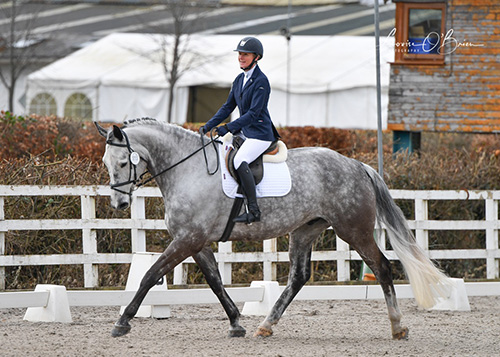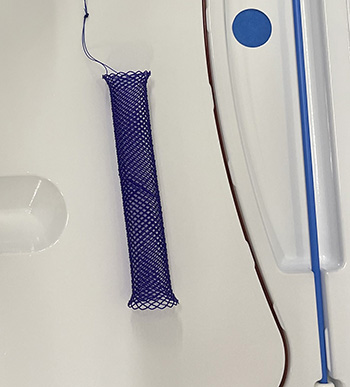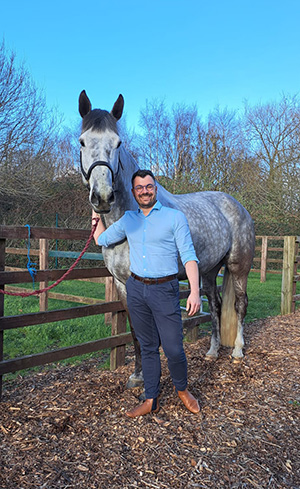UCDVH Equine Surgery & Small Animal Medicine Teams Collaborate on Unique Advanced Urinary Stenting Procedure
The UCD Veterinary Hospital Equine Surgery and Small Animal Medicine Teams recently collaborated on an advanced urinary stenting procedure to alleviate urinary obstruction in a horse. This is only the second time this procedure has been reported in a horse and the first time it has been carried out on a standing horse, using a combination of sedation and local anaesthesia.
 Maestro, a 10 year old Irish Sport Horse Gelding (pictured, right), underwent severe complications from a general anaesthesia in 2018 leading to him being catheterised very frequently for a short period of time. He subsequently began to present signs of pain on urination - vocalisation and an abnormal urinary pattern. At the time, Maestro was diagnosed with sabulous cystitis, an inflammatory condition leading to an accumulation of sediment in the bladder.
Maestro, a 10 year old Irish Sport Horse Gelding (pictured, right), underwent severe complications from a general anaesthesia in 2018 leading to him being catheterised very frequently for a short period of time. He subsequently began to present signs of pain on urination - vocalisation and an abnormal urinary pattern. At the time, Maestro was diagnosed with sabulous cystitis, an inflammatory condition leading to an accumulation of sediment in the bladder.
Further catheterisations were performed to administer treatment, however the relief from the discomfort became shorter between each treatment. Catheterisation became more difficult and a urethral stricture (narrowing of the urethra in the penis) was diagnosed in 2021.
Since then, the pain associated with urination continued to progress despite supportive care and attempts to dilate the stricture with balloon inflation and local steroid administration. Maestro was not able to fully void his bladder at once without experiencing pain and he also had urine dribbling between urination attempts.
Maestro's owner and vets began to have concerns about his quality of life due to the constant pain associated with Maestro voiding and the development of urinary incontinence which can lead to scalding when it becomes chronic.
 Based on one previously published case in a horse, Clodagh Kearney from our Equine Surgery Team proposed a collaboration with Small Animal Internal Medicine specialist Benoît Cuq for a minimally invasive intervention, guided by both endoscopy and ultrasound. A stent (pictured, left), a resorbable cylindric device applying a radial force, was used to reopen the narrowed urethra to almost its original diameter.
Based on one previously published case in a horse, Clodagh Kearney from our Equine Surgery Team proposed a collaboration with Small Animal Internal Medicine specialist Benoît Cuq for a minimally invasive intervention, guided by both endoscopy and ultrasound. A stent (pictured, left), a resorbable cylindric device applying a radial force, was used to reopen the narrowed urethra to almost its original diameter.
The procedure was a success and Maestro was able to void normally and fully empty his bladder straight away. After a number weeks on pain management and anti-inflammatory drugs, a repeat endoscopy was carried out to ensure that the device had not been displaced. The endoscopy showed that the stent was well embedded and that the opening was wide enough to allow for normal voiding.
 Maestro recently had his 6-month post-intervention check up (pictured, right, with Benoît Cuq from our Small Animal Medicine Team) and we are delighted to report that he is clinically back to normal and his urethra looks healthy, and is no longer inflamed or narrowed; his urinations are normal and pain is no longer part of his daily life. Maestro is now happily back at work with his owner as a beautiful dressage horse!
Maestro recently had his 6-month post-intervention check up (pictured, right, with Benoît Cuq from our Small Animal Medicine Team) and we are delighted to report that he is clinically back to normal and his urethra looks healthy, and is no longer inflamed or narrowed; his urinations are normal and pain is no longer part of his daily life. Maestro is now happily back at work with his owner as a beautiful dressage horse!
Combining the expertise of multiple specialists at the UCD Veterinary Hospital, we were able to provide Maestro with a fresh start using a novel and minimally invasive procedure. Minimally invasive interventions are now becoming much more frequently used in veterinary medicine and the outcomes from these procedures can be life changing and life saving for the patients involved.
Find out more about the range of services available at the UCD Veterinary Hospital here.